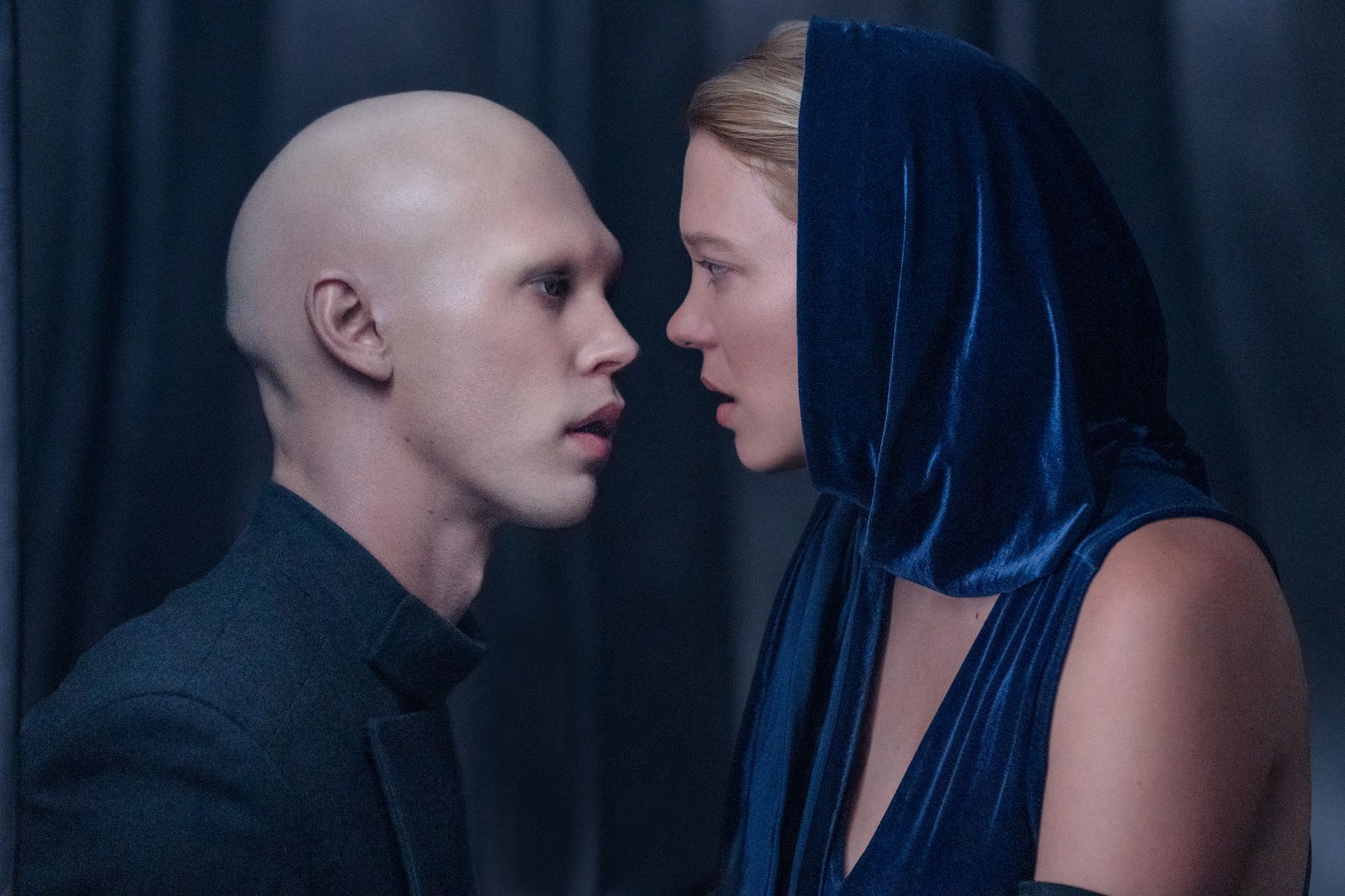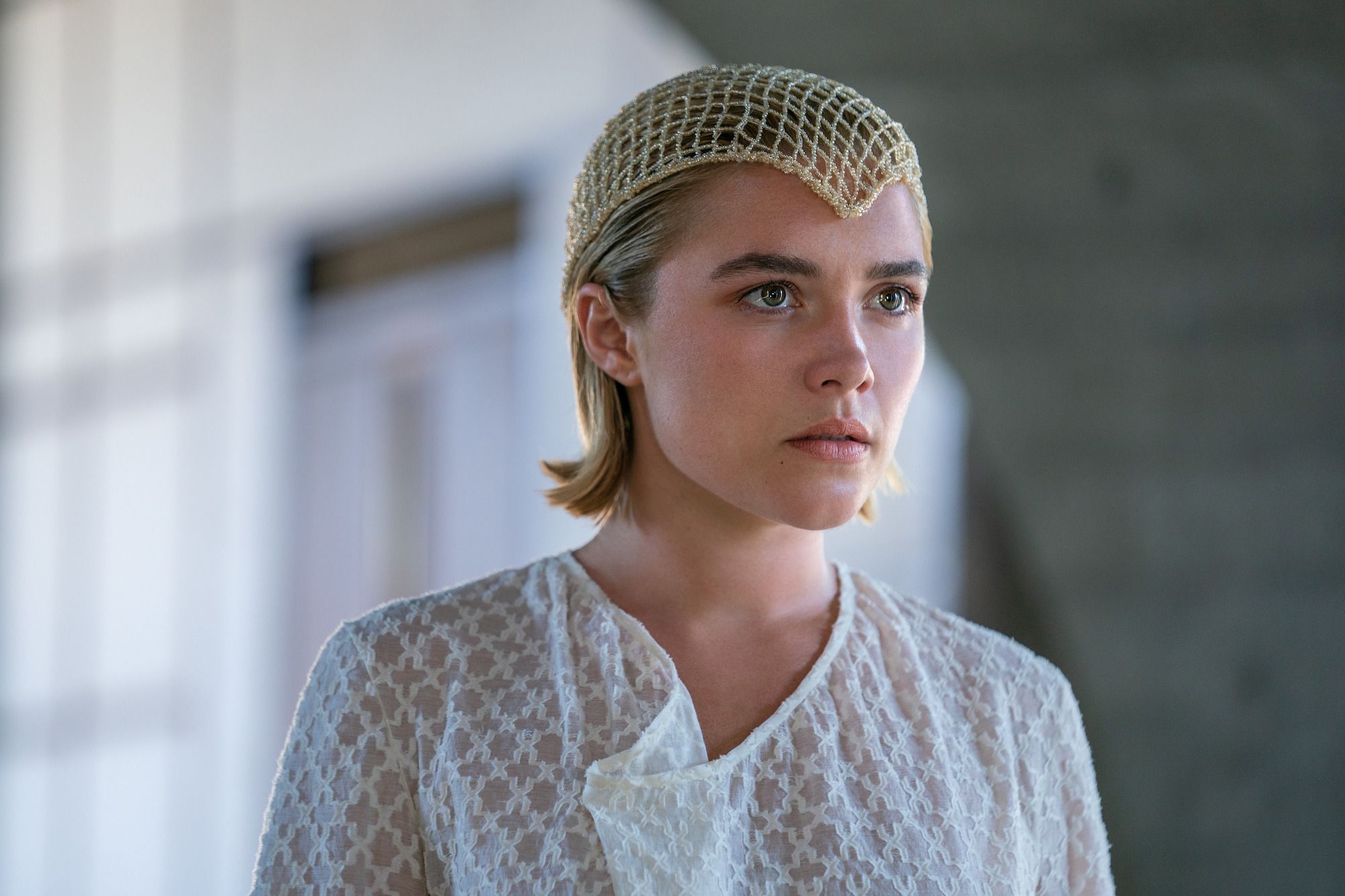Sandworms, spice-mining, stillsuits, silly walks, spacecraft shaped like dragonflies, nifty nosepieces, Bedouin chic, retro-futurism, neo-fascism, oh-look-there’s-Dave-Bautista-ism…
If none of these means anything to you then clearly you have not seen director Denis Villeneuve’s multiple Oscar-winning sci-fi epic Dune — nor, perhaps, read the 1965 Frank Herbert potboiler-phenomenon on which it was based. No matter, unless you’re planning on watching Villeneuve’s Dune: Part Two, in which case you can happily skip the novel, but you should at least see the first film, erm, first, or risk intergalactic befuddlement — an acute condition that no amount of breath-taking battle scenes or stellar casting could cure.
Dune, released in 2021, starred the ubiquitous Gen Z pin-up Timothee Chalamet and the mononymous Gen Z pin-up Zendaya — an otherworldly coming together of cheekbones and gorgeous doe eyes — alongside Thanos, Aquaman, Poe Dameron, and Ilse Faust. Plus, one for the Boomers, Charlotte Rampling as a malevolent nun.
That film did a remarkable job of making almost comprehensible a plot so convoluted that all previous attempts to bring Herbert’s magnum opus to the screen had ended in failure. Both David Lynch and Alejandro Jodorowsky — supremely gifted and distinctive filmmakers — found themselves sinking in the quicksand of the novelist’s incontinent “world-building”. (In Lynch’s case his 1984 movie bombed; serves him right for casting Sting. In Jodorowsky’s, $2m was squandered developing a movie that never went into production, perhaps a mercy given the Chilean director envisaged a Dune of 14 hours’ duration — although the mere idea of Salvador Dali as the Emperor is still enough to induce a pang of regret at opportunities missed.)
The relative triumph of the most recent Dune — there have also been TV adaptations, with which we need not detain ourselves — is in some measure due to Villeneuve’s decision to film Herbert’s novel over two parts, the first, as is the way with these things, effectively functioning as an extended trailer for the second. There’s nothing new about Hollywood movies being conceived as marketing tools for themselves, with inconclusive endings teasing forthcoming sequels. The cliff-hanger dates back a century, to the days of silent-era Saturday morning serials — and further back than that, to episodic Victorian novels. (Thomas Hardy, no less, is the writer usually credited with the actual hanging-off-a-cliff trick.) In the case of Dune, the structure makes sense, since the source material is so dense and, not to put too fine a point on it, incredibly fucking long.
Villeneuve’s 2021 Dune was nothing if not spectacular, as you’d expect from the filmmaker behind such striking alien encounters as Arrival (2016) and Blade Runner 2049 (2017). Nevertheless, while it was perfectly possible to kick back in your multiplex recliner and bliss out on the hallucinatory visuals — mood board: Fry’s Turkish Delight commercials; Steve McCurry’s famous Nat Geo cover; Lawrence of Arabia; Beyond Thunderdome; Tatooine by Calvin Klein; Nuremberg — it remained a bit of a slog trying to figure out exactly what Herbert had been driving at, all those years ago.
A soupy tagine of orientalism, medievalism, classicism, myth, legend, religious mumbo jumbo, and space operatics (neophytes will be forgiven for thinking Herbert steals wholesale from Star Wars, when in fact it was the other way around, George Lucas borrowing liberally from Dune), the novel takes what initially appears to be a reasonably straightforward narrative — the archetypal hero’s journey, subverted — and buries it under so much sand and strained-for significance it might cut off the oxygen supply to your brain.
Herbert threw everything he could think of into his baggy monster, and while there is, terrifyingly, an argument to say his concerns have never been as timely — fear of religious fundamentalism, jihad, nuclear armageddon, environmental calamity, an extinction event — they don’t, in Villeneuve’s faithful adaptation, make for a light-hearted cinematic experience. “This world is beyond cruelty,” we are told, in Dune: Part Two. No shit. Pass the popcorn.
Dune, for those new to the franchise, tells the story of Paul Atreides, scion of the House Atreides: not a fashion maison, although Timmy C shills for those too, but an ancient aristocratic lineage. When the noble Atreides are dispatched by the shadowy Emperor to the desert planet Arrakis to take over management of the all-important resource known as spice from the rival House Harkonnen, all the conditions are in place for a violent conflagration. But first Paul meets the indigenous population of Arrakis, the Fremen — sort of sexy mujahideen — including the girl of his dreams-slash-nightmares, Zendaya’s Chani, glimpsed only briefly in Dune, but more fully developed in Part Two.
Matters are complicated, in both films, by the presence of Paul’s mother, the powerful and mysterious Jessica, a member of the Bene Gesserit, an all-female kick ass superpowered martial arts troupe — still with me? — and by the fact that some think Paul might be the Lisan al-Gaib (“Voice from the other world”) and / or the Mahdi (“The one who will lead us to paradise”). He also answers to Muad’Dib (after a big-eared desert mouse, obviously) and Usul — meaning, apparently, “the base of the pillar.”
So he’s the Messiah, basically. Or he’s a false prophet. One of the two. Gosh, it’s so hard to decide, isn’t it? Maybe have a massive holy war and the winner gets to choose?
Part Two, then, takes up as expected, where the first film left off. The Nazi-like Hakonnen — these guys are so dark that their home planet, Giedi Prime, exists only in black and white — have killed almost all the Atreides and are now torching the evidence with flame-throwers. Cue piles of burning bodies. Paul and his mother have escaped into the desert and been rescued by the Fremen. But Paul is gifted, or cursed, with horrifying premonitions. He sees that the closer he allies himself with his new friends, the more likely it is he will bring death and destruction to their world.
The opening sequences are gripping and fast-paced. Villeneuve is a superbly accomplished director of action set pieces, able to conjure great tension and drama where most CGI blockbusters are content to summon tiresome sturm und drang. (If you haven’t seen Sicario, his thrilling war-on-drugs drama from 2015, drop everything and do that instead.) The sequel is more violent and doomier than its predecessor — appropriately so, given one of its essential themes is disenchantment. Hans Zimmer’s score is even more thunderous. The baddies are even more murderous. The sense of jeopardy is sharper. This is all to the filmmakers’ credit, especially given that at times the book can be such a plod.
If Dune: Part Two has a flaw that Herbert can’t be blamed for, it lies with its lead couple. Chalamet and Zendaya are undeniably appealing. They look lovely in red carpet Instagram posts. But the former seems to me too winsome and wraithlike to convincingly embody a vengeful rabble rouser. And unlike in the case of his Harkonnen enemies, who can float above the earth — an amazing scene — his romance with Zendaya never quite takes off. Perhaps it lacks that ingredient crucial to the survival of the species: spice.
“I’d very much like to be equal to you,” Chalamet says to his azure-eyed paramour, before they kiss. It may be the most purely Millennial love scene ever committed to digital — chastely respectful and tepid — and it is played without a hint of knowing humour.
The firecracker British actor Florence Pugh, on the other hand, can enliven any scene with a bare minimum of dialogue — which is handy, as that’s all she gets. As the scheming fashion-plate daughter of Christopher Walken’s Emperor, Pugh effortlessly commands the screen. It would have been nice to see more, too, of Lea Seydoux, and a blink-and-you’ll-miss-her Anya Taylor-Joy.
Austin “Elvis” Butler gets some menacing scenes as an evil slaphead, Feyd-Rautha; he looks a bit like Man City’s Erling Haaland would if the Viking-like striker were to suddenly contract alopecia. Javier Bardem and Stellen Skarsgard both have fun munching on the considerable scenery, as the God-bothering Fremen leader, Stilgar, and bellicose Baron Harkonnen, respectively. As in the first film, Rebecca Ferguson is formidable as Paul’s witchy mother, this time with added face tattoos. The also-returning Josh Brolin does his grizzled warrior thing with varying levels of enthusiasm. (Entirely projection on my part, but I sensed a certain fellow-feeling with Brolin, who looked at times somewhat bemused by events.)
After close to three hours — six, including the first film — everything is left, true to Herbert again, deliberately unresolved. And perfectly poised for another sequel, following the events outlined in Dune Messiah, Herbert’s 1969 follow-up to his original smash hit.
Until then, altogether now, in your best Terry Jones voices and with apologies to an unacknowledged influence on Dune: Part Two, Monty Python’s Life of Brian: “He’s not the messiah, he’s a very pretty boy…”
Or, maybe, he’s the messiah?
Find out in Dune: Part Three.
Dune: Part Two is in cinemas from 28 Februry.














